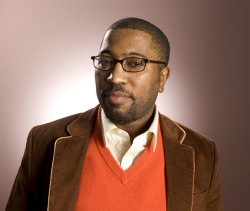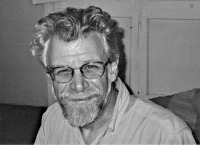Lectures: October to mid-November
Full Professor Lecture
 English Professor Major Jackson's Full Professor Lecture, "The Dadaab Suite and Other Poems," will be on Tuesday, October 4, in Waterman Memorial Lounge, at 5:00 p.m. Dadaab, Kenya is the home of the oldest and largest refugee camp administered by the United Nations High Commissioner for Refugees. The camp was built for 90,000 refugees in 1991 as a consequence of the civil war in Somalia. Currently, the camp is now host to 380,000 people, and since the beginning of the summer, the current famine in Somalia has swelled those ranks even higher. As one reporter wrote, This is one of the most desperate places on Earth.” As part of a cultural diplomacy trip sponsored by the United Nations, the United States Department of State, and the University of Iowa International Writers Program, Poet and Professor Major Jackson visited Dadaab to conduct creative writing workshops, meet with aspiring writers within the camps, and witness the current crisis in the northeastern region of Kenya. Professor Jackson will present a multi-media presentation of his experience and read new poems that address war, the limits of witnessing as well as the resilient spirit of the Somalian people.
English Professor Major Jackson's Full Professor Lecture, "The Dadaab Suite and Other Poems," will be on Tuesday, October 4, in Waterman Memorial Lounge, at 5:00 p.m. Dadaab, Kenya is the home of the oldest and largest refugee camp administered by the United Nations High Commissioner for Refugees. The camp was built for 90,000 refugees in 1991 as a consequence of the civil war in Somalia. Currently, the camp is now host to 380,000 people, and since the beginning of the summer, the current famine in Somalia has swelled those ranks even higher. As one reporter wrote, This is one of the most desperate places on Earth.” As part of a cultural diplomacy trip sponsored by the United Nations, the United States Department of State, and the University of Iowa International Writers Program, Poet and Professor Major Jackson visited Dadaab to conduct creative writing workshops, meet with aspiring writers within the camps, and witness the current crisis in the northeastern region of Kenya. Professor Jackson will present a multi-media presentation of his experience and read new poems that address war, the limits of witnessing as well as the resilient spirit of the Somalian people.
Jackson is the author of three books of poetry: Holding Company, Hoops, and Leaving Saturn, a finalist for the National Book Critics Circle Award in Poetry. He work has appeared in American Poetry Review, The New Yorker, Poetry, and twice in the anthology Best American Poetry (2004, 2011). He is a recipient of a Pushcart Prize, a Whiting Writers' Award, a Pew Fellowship in the Arts, and a Witter Bynner Fellowship from the Library of Congress. He is the Poetry Editor of the Harvard Review. He is the Richard Dennis Green and Gold Professor at University of Vermont.
Dean's Lecture
 Art History Professor William Mierse will speak about "How Clothes make the Man: Textile Art in Ancient Central Asia" as part of the CAS Dean's Lecture Series. The lecture takes place on Tuesday, November 1 at 5:00 p.m. in the Waterman Memorial Lounge.
Art History Professor William Mierse will speak about "How Clothes make the Man: Textile Art in Ancient Central Asia" as part of the CAS Dean's Lecture Series. The lecture takes place on Tuesday, November 1 at 5:00 p.m. in the Waterman Memorial Lounge.
The lack of surviving textiles is one of the major gaps in our understanding of ancient art. We know that they were important. Literary references going back to the third millennium BCE tell of their significance. As clothing they could be used to indicate an individual’s social status, wealth, ethnic affiliation, or religious association. As wall hangings, they may have rivaled mural paintings. However, the archaeological record has preserved few examples until quite recently. Excavations over the last twenty years in the Taklimakan Desert in China’s Xinjiang Province have begun to reveal rich finds of textiles. These objects are forcing us to change our understanding of the nature of the artistic exchanges between the ancient Mediterranean and Chinese regions and are providing us with a glimpse of the sophisticated artistic production that occurred in Central Asia where influences from the West and the East came together along with indigenous cultural forces to produce these textile works. In this talk, Mierse explores one particularly intriguing textile find from Yingpan.
Mierse has been at UVM since 1988 and serves in the Departments of Art and Art History and Classics. He was Chair of the Department of Art and Art History from 1994 to 2000 and has also directed the program in Latin American Studies and co-founded and directed the Near Eastern Studies program. He promotes the study of Humanities and Classics throughout New England and has regularly participated in the Classical Association of New England Summer Institute, which he also directed in 1994 and 1995. He is the author of Temples and Towns in Roman Iberia, The Social and Architectural Dynamics of Sanctuary Designs from the Third Century B.C. to the Third Century A.D. (University of California Press, 1999), Ocho Ensayos Intrepretivos sobre el Arte Romano (Universidade de São Paulo, 2000), and co-author with George M.A. Hanfmann of Sardis from Prehistoric to Roman Times (Harvard University Press, 1983). His newest book, Temples and Sanctuaries from the Early Iron Age Levant, Recovery after Collapse, is being published by Eisenbrauns and is due to appear in 2012.
The Dean's Lecture Series was established in 1991 as a way to recognize and honor colleagues in the College of Arts and Sciences who have consistently demonstrated the ability to translate their professional knowledge and skill into exciting classroom experiences for their students -- faculty who meet the challenge of being both excellent teachers and highly respected professionals in their own disciplines. The award is a celebration of the unusually high quality of CAS faculty and has become an important and treasured event each semester.
******
Please note: All lecture speakers, topics, start times, and locations are subject to change.
 English Professor Major Jackson's Full Professor Lecture, "The Dadaab Suite and Other Poems," will be on Tuesday, October 4, in Waterman Memorial Lounge, at 5:00 p.m. Dadaab, Kenya is the home of the oldest and largest refugee camp administered by the United Nations High Commissioner for Refugees. The camp was built for 90,000 refugees in 1991 as a consequence of the civil war in Somalia. Currently, the camp is now host to 380,000 people, and since the beginning of the summer, the current famine in Somalia has swelled those ranks even higher. As one reporter wrote, This is one of the most desperate places on Earth.” As part of a cultural diplomacy trip sponsored by the United Nations, the United States Department of State, and the University of Iowa International Writers Program, Poet and Professor Major Jackson visited Dadaab to conduct creative writing workshops, meet with aspiring writers within the camps, and witness the current crisis in the northeastern region of Kenya. Professor Jackson will present a multi-media presentation of his experience and read new poems that address war, the limits of witnessing as well as the resilient spirit of the Somalian people.
English Professor Major Jackson's Full Professor Lecture, "The Dadaab Suite and Other Poems," will be on Tuesday, October 4, in Waterman Memorial Lounge, at 5:00 p.m. Dadaab, Kenya is the home of the oldest and largest refugee camp administered by the United Nations High Commissioner for Refugees. The camp was built for 90,000 refugees in 1991 as a consequence of the civil war in Somalia. Currently, the camp is now host to 380,000 people, and since the beginning of the summer, the current famine in Somalia has swelled those ranks even higher. As one reporter wrote, This is one of the most desperate places on Earth.” As part of a cultural diplomacy trip sponsored by the United Nations, the United States Department of State, and the University of Iowa International Writers Program, Poet and Professor Major Jackson visited Dadaab to conduct creative writing workshops, meet with aspiring writers within the camps, and witness the current crisis in the northeastern region of Kenya. Professor Jackson will present a multi-media presentation of his experience and read new poems that address war, the limits of witnessing as well as the resilient spirit of the Somalian people.  Art History Professor William Mierse will speak about "How Clothes make the Man: Textile Art in Ancient Central Asia" as part of the CAS Dean's Lecture Series. The lecture takes place on Tuesday, November 1 at 5:00 p.m. in the Waterman Memorial Lounge.
Art History Professor William Mierse will speak about "How Clothes make the Man: Textile Art in Ancient Central Asia" as part of the CAS Dean's Lecture Series. The lecture takes place on Tuesday, November 1 at 5:00 p.m. in the Waterman Memorial Lounge.